#how do you?? draw children?? how do their proportions work??
Text

xia sini
#mo ran#xia sini#chu wanning#erha#2ha#how do you?? draw children?? how do their proportions work??#anyway he’s tiny and i love him#the husky and his white cat shizun#erha he ta de bai mao shizun#fanart#artsyfartsy#sketch#sketchbook#daily sketch
22 notes
·
View notes
Note
Hi! So I want to make a Spooky Month OC but I suck at drawing, do you have any tips or advices about drawing characters in the Spooky Month artstyle?
Okay so, I might not be the right person for this, cause I also am not all that great at drawing in the Spooky Month artstyle, but I did some character design at school so I might be able to give a few tips! Please do take everything I say with a grain of salt tho!
Spooky Month's strong suit is definitely character design. It's SO expressive and well done it's genuinely unreal. You might want to know exactly what your character is gonna be doing, or how their personality is gonna be like, because character design in Spooky Month cares a lot about things like these. For example: Radford works at a cinema, so of course he's wearing 3D glasses, but also his HAIR IS LITERALLY SHAPED LIKE A POPCORN.
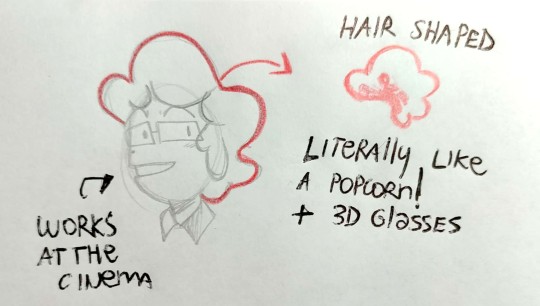
So maybe decide on a job for your character, and try to start from there, get crazy with shapes and have fun! Spooky Month characters have designs that are both extremely simple to draw, since they use mostly basic shapes, but also are extremely thought out and meaningful. Another example of great character design is Pump
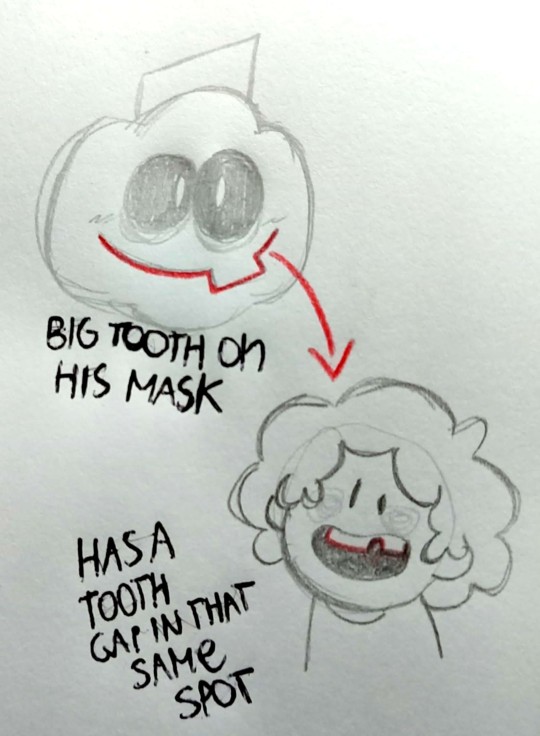
Now, I have no idea if you already had an OC in mind, but make sure to choose the right shapes to represent it. Something I see around in the fandom is people making these OCs that are like, serial killers and dangerous people and stuff, but then give them the "Lila"-like oval head. And honestly, nothing wrong with that, that's a choice you can use! But still, shapes allow us to understand a lot about how a character is just by looking at them. So you might want to experiment around a bit!
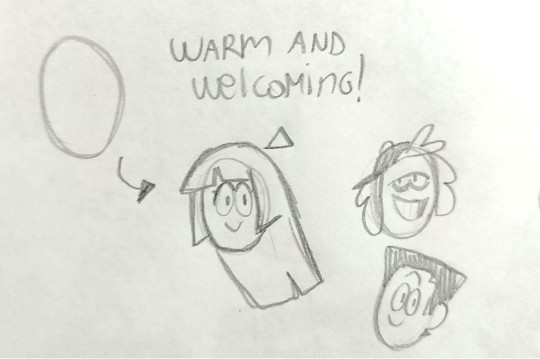
Ovals in Spooky Month are the "good" shape, let's just say. Most character with an oval head are sweet, helpful, kind-natured! It's often paired with oval eyes, so it's mostly a shape that's used for not villainous characters.
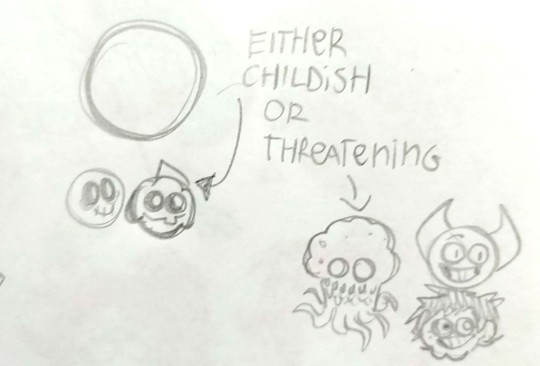
Circles are a bit more complicated, because Spooky Month subvertes the Circle Characters. While yes, they're also used to draw children, such as Skid and Pump, so they may come off as unthreatening at first, most main villains, such as Eyes, Bob and Dexter Doll (which is meant to represent the likes of a child, so that's a nice contrast), are mostly circle-shaped.

There's a very wide range of Square characters in Spooky Month. Square characters are usually bulky, big and strong. They often come off as threatening (such as Moloch), but there are so many other fun things you can do with them. Like, take Frank. EVERYTHING in his design should alarm us, him being square-shaped, the black eyes, the wide smile. Yet, he has a shape of the eyes that's very relaxed and chill, so we end up trusting him. As for Dexter, he's a mix of circles and squares, so we can't really understand his intentions right away, because he's shaped in the most confusing way possible. He's just made to be unsettling and leaving us to wonder if he's a bad guy or just an oddball.
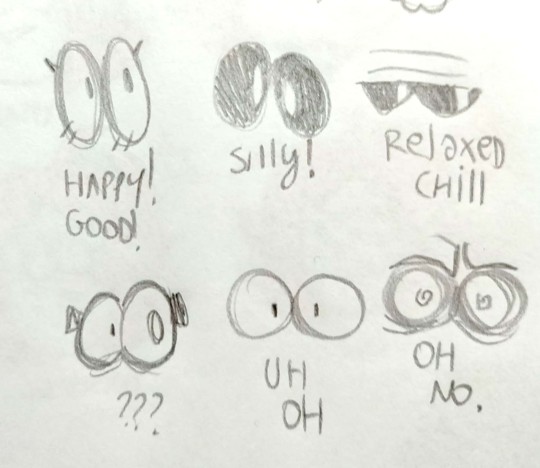
You can do SO MANY fun things by mixing up shapes of faces and eyes it's INSANE. Also, you can mix up other characters' features to create a new one, if you're planning to do a fankid or stuff like that. Look at Ross, he's literally a mixture of all his parents' features!

My main tips for drawing in the Spooky Month artstyle are mostly
1) Play around with shapes. Be as cartoony as possible.
2) Try to be consistent with proportions, because, based on personal experience, if you draw the pupils of the eyes slightly off it changes the whole character's expression drastically
3) don't worry too much about details, Spooky Month has a very simple artstyle. You don't have to draw a perfectly anatomically correct hand, just whip up some cartoony three-to-four fingers and you're good to go
4) try to redraw some pre-existing screenshots from the serie to get familiarity with the way Pelo draws expressions. It helps a bunch.
So yeah, that's all! Good luck with your oc :)
#spooky month#spooky month art#spooky month oc#spooky month au#spooky month fanart#radford spooky month#spooky month radford#sm radford#sm ross#spooky month ross#spooky month dexter#dexter erotoph#sm dexter#dexter doll#sm moloch#moloch#spooky month moloch#sm jaune#spooky month jaune#spooky month aaron#sm aaron#spooky month frank#sm frank#spooky month skid#skid and pump#sm skid#pump wonder#sm pump#spooky month pump#spooky month eyes
71 notes
·
View notes
Text
Processing Process, and More Processing
I made this post free and publicly readable on Patreon, but I'm reposting the whole thing right here too because, well, it's a free post, and I don't want to make you click away from your dashboard if you don't need to. But also if you want to support my work, here's the link to the post.
It's a little bit about cartooning, a little bit about drawing, and then it turns into a eulogy for a chicken.
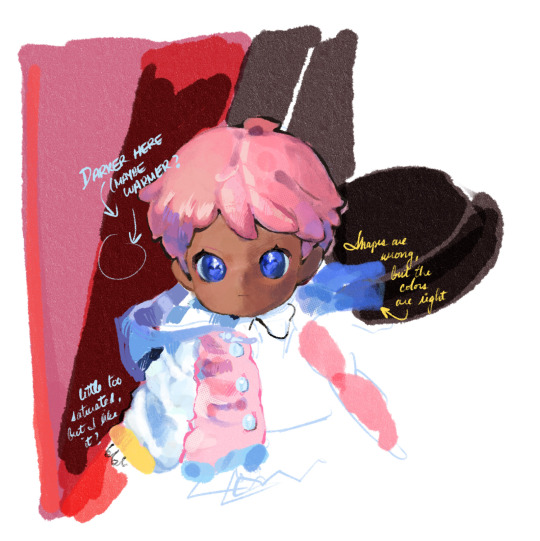
I wrote “process” more than once, and now the word looks funny and is beginning to lose its meaning to me.
This post is about a few things, and it’s a little bit on the sad end of things. Nothing dire! No worries. There’s just a little mention of death, just as a heads up.
Before we get to that, though, I’ve been doing some work and had some thoughts.
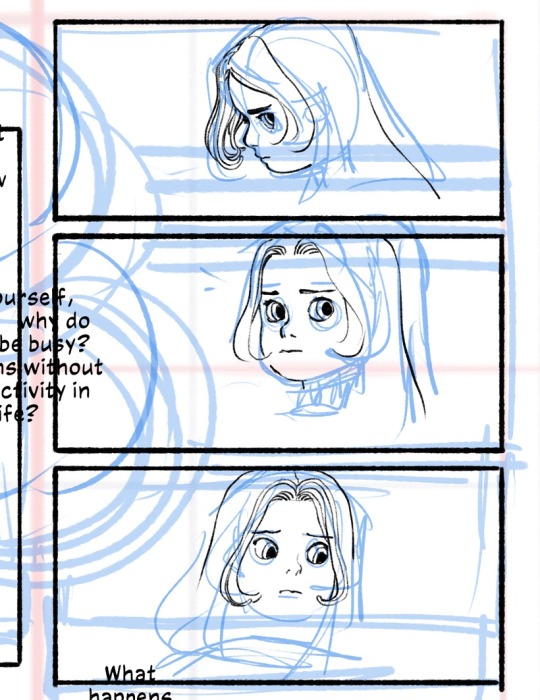
I’m often asked about how I draw the noodle hair on my characters, and the answer is typically that I draw each and every line with my hand. But there are considerations of movement and volume that go into it beyond its texturally decorative purposes. I love being able to convey shape and motion with it. It’s less evident, I think, in my illustration work, but I think it’s much more obvious when I do sequential work. In the above image, you can see me working out a sequence of Angelica having a series of thoughts. Her head sort of moves, and her eyes follow. You can see I’d planned out the general shape of the hair and how I’d like it to move.
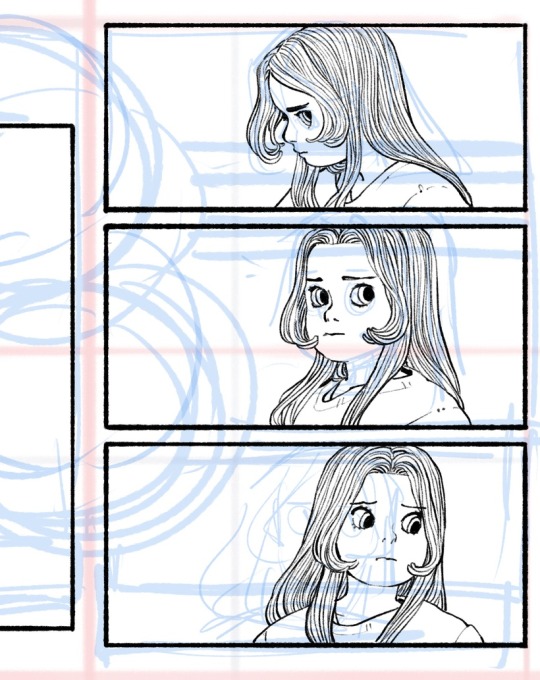
I wound up moving the drawings a little bit so that the readers eyes will actually follow the character’s eyes as it moves gently rightward on the page. The hair is there to accentuate the movement, like so:
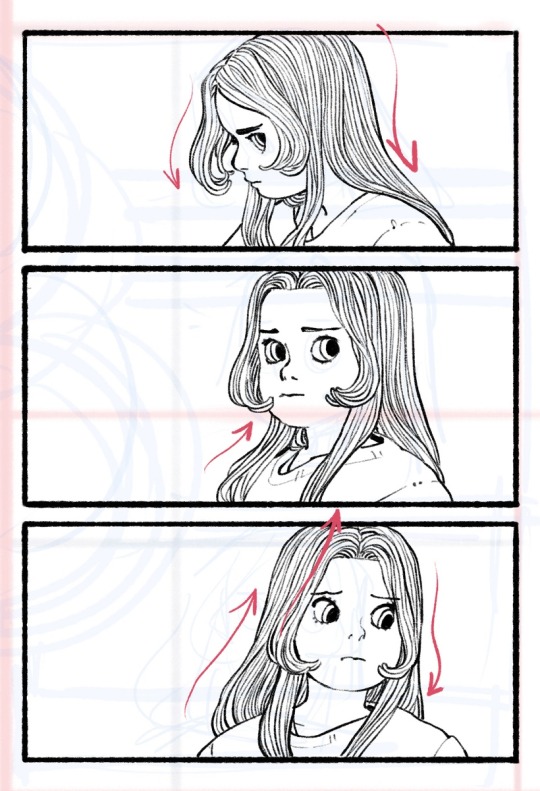
It’s a consideration I employ in all my drawings, but especially when I’m drawing hair and fabric. I don’t use a lot of action lines, so this becomes an important way to give the reader the information that someone is moving through a space. Resistance, gravity, and motion are all things I have to keep in the back of my head when I’m doing these little drawings. I think the planning actually takes more time than the inking, which can happen pretty quickly once I map it all out.
In other news, I’m starting to take my extracurricular artistic development a little more seriously in the silliest way possible.
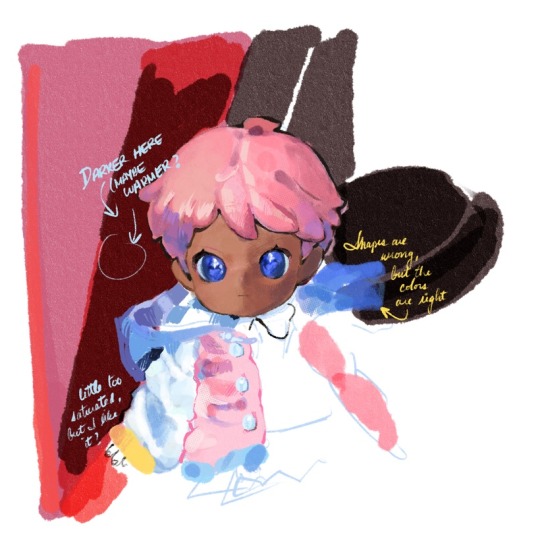
You wouldn’t know it, but I studied painting college—a medium I switched to after the printmaking professor and head of the Art Department at the time told me I probably shouldn’t be an artist (he gave me a hard candy for my trouble). I recently bought a bunch of little dolls, dressed them up, and am returning to my painting roots. It feels really nice to work in big blobs of color instead of lines. It’s an exercise I came up with in response to a common lament from art students.
One of the more aggravating generational tensions described to me by art school students is when professors describe a student’s portfolio as “too anime” without much explanation. I know what the professor means. They’re trying to get at how referencing your favorite anime or cartoons means that your style becomes a simulacrum, an imperfect copy of a copy, and you never learn to develop your own sense of judgment about where a line or a shape needs to go. And we can tell. It’s a way of working that is perfectly fine for cartooning because cartooning is closer to hand-writing than it is to drawing. I always turn to Charles Schulz’s work for an example. Those figures aren’t literally depicting children—with their little chessboard-pawn proportions and bread-loaf feet—but we read them as endearing children because we’ve come to a consensus between us, the readers, and Charles Schulz, the author, that those shapes mean those things. There are no whiskers or paws in the shape of the word “CAT” but you look at those three letters together, and you know the thing to which it refers. That’s an aspect of cartooning, too. Of course, what elevates it from mere writing is, in part, due to the fact that those little figures do not lose their meaning the more you depict them.
To really draw well, though, you have to do those fundamentals. You have to draw from life. There’s no way around it. It helps you develop a stronger sense of where you like to lay down your lines and shapes, no matter how stylized you like to work. It grows your judgment, and every artist’s best tool is their own well-honed sense of artistic discernment about their own work.
But that doesn’t mean you have to surrender the stuff you like or the things that inspire you to make art! I tell students that if they want to hold fast to their anime style AND hone their fundamentals to develop their eye as an artist, they should buy little figurines and toys of their favorite characters, prop those up against a light source, and draw them as still life objects. Like, yes, do the vases and the figure drawings and all those, I still think those are important. But if this is what you need to keep you interested in drawing from life, having some toys around is a great way to do it! Also, bless those sculptors and toy designers. They’re the best.
I think there’s something to be said about remembering to imagine the physicality of the things we draw, in all its dimensions and in the way it catches the light or casts a shadow. It helps sentimentalize things, too. Makes them feel more real, even emotionally.

Edwina died on Tuesday night, after a few final snuggles, surrounded by her favorite treats. She was about five years old, which is old for a chicken, and she had a very comfortable life. We buried her this morning. She was a good hen, J’s personal favorite.
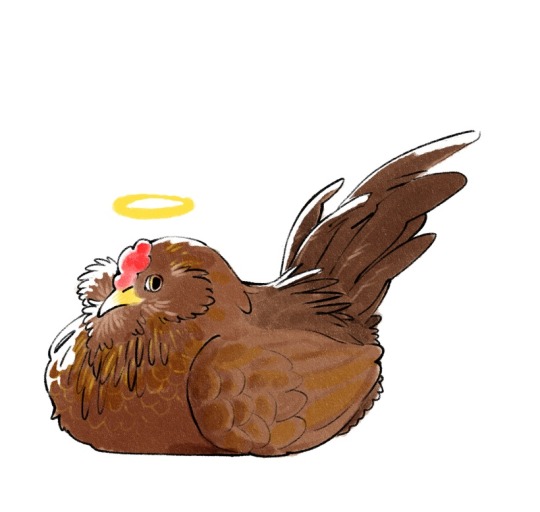
It really feels like the end of an era. She was the last surviving member of our very first flock. After the other hens died, she really seemed to prefer the company of people over other hens. She is survived by Snooki and Nelly, our two other young birds who get along quite well together, actually.
A baby chick costs between three and five American dollars, typically. An egg-laying hen could be between twenty and fifty bucks, depending on the breed. There are roughly 26 billion chickens living in the world today, about 518 million of them here in the United States. They come pretty cheap. And a part of me was moved to cynicism, entertaining the thought that it might be strange to feel sadly over a little animal that, at most, might be roughly equivalent to the price of a fancy lunch and a coffee.
I watched the 1974 musical version of The Little Prince recently, and I remember it mostly because Bob Fosse was in it and scared the crap out of me as a kid—he played the snake that would take the Little Prince back into the sky when his body gets too heavy to take with him. Gene Wilder plays the Fox whom the Little Prince befriends and tames among a garden of roses. The Fox explains that he is like any other fox in the world, but he is changed—made special and particular to the Little Prince—with time, effort, and patience. So, too, is the Prince’s little flower special to him. Out of all the flowers in the universe, she was the one he watered and protected under a little glass jar. And that’s enough.
I knew my little hen would not live that long. It could be very easy to take a broad view of the life expectancy of a hen and distance myself from it by virtue of its mortality and its commonness. People who raise livestock do it all the time. But I also think it’s wonderful that we should all be capable of loving very small, very brief little things. Edwina is not, to my mind, the rough equivalent of a fancy lunch and a coffee. She was our little hen. For her whole life, she was ours. And I’m so happy she was here.
104 notes
·
View notes
Note
Do you think Lucius was jealous of Saul's battle brothership with Garro?
Pre-Heresy Lucius is an insecure guy through and through. He knows he's really, really excellent at one thing and that's the only thing he wants to be recognised for. It's not for nothing that his gamerules mention that he was mocked by his brothers for how good-looking he is (and in a legion of perfectly proportioned men, that's quite a feat!). This mockery has certainly contributed to the fact that he defines himself even more than the rest of the Emperor's Children by his perfection in battle. Because that is something he has achieved himself and was not randomly distributed in the genetic lottery. (Of course, this also ensures that he later tries all the harder not to be pretty. Only to then regret it, entrance Hathor Maat stage left, etc, etc …)
All this preamble just for: In contrast, Saul is a self-contained team player. Far too unambitious for a son of Fulgrim, but a gifted strategist and empath. He works with what he has - and he has Lucius (among others). A very effective tool which, although difficult to control, can achieve astonishingly good results if used correctly. And a tool that has decided that it is incredibly fond of Saul.
So Saul has to constantly juggle the fact that Lucius wants to shine on the one hand, but also has a lot of destructive potential on the other. That really is very high maintenance!
Garro on the other hand is …. errr … there. Yes, definitely. Uncomplicated, effective and - in direct comparison to Lucius - very, very predictable.
I suppose, lore-wise, this friendship is supposed to represent the fact that Saul simply needs a break from time to time. I can't explain it any other way.
For Lucius, it's probably much, much more incomprehensible. What does Saul want with this astartes version of unflavoured porridge?
Is he really jealous? It's hard to say. In the sense that Lucius is jealous of everything that draws Saul's attention away from him, probably yes. But really deep down? Probably not, as he can think of absolutely no reason why Garro should be even the slightest bit more interesting than him.
Slightly disgusted amazement? Shaking his head as to why Saul doesn't look for something better? Anger that boredom apparently has a certain appeal? That could be it!
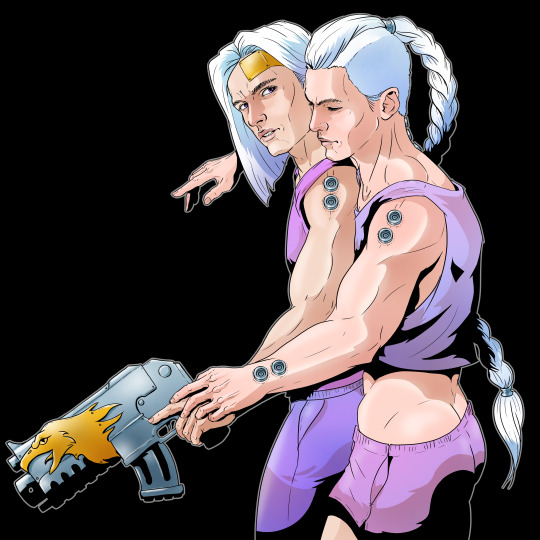
59 notes
·
View notes
Note
Hey Stiff,
@scittiesenjoyer here (why won’t Tumblr let me ask from a side blog)
I kinda went off in the tags of two anonymous asks you got implying you were racist for giving Scar a big nose in your art
I’m here to double down
Because I love your art and seeing you in the community and it makes my blood boil to think that some dickhead accusing you of something you didn’t do will make you feel less welcome here (honestly I wanna be a lot meaner to that anon, but I’m choosing to believe that they were coming from a good place and are just ignorant rather than malicious)
Anon has taken a very real issue and over applied it to the point of almost parody. I would like to make it clear that I am white myself and was raised Christian (agnostic now not that it really matters), so by no means an expert on the issues faced by others. But I do listen to Jewish people and have read into the topic of harmful Jewish stereotypes seemingly more than anon. Prepare for me to give you two whole sources more than that anon
Yes overly large noses (often also hooked) are used in caricatures of Jewish people, but never in complete isolation. Here’s a post on Jew-coding, the practice of applying character traits that make you think of Jewish people. Which can be good or bad, depending on what is making you think of Jewish people
https://www.tumblr.com/roach-works/703234602671751168/on-jew-coding
It doesn’t touch on large noses, though it is often brought up in discussions around art and animation. Especially as villains are often negatively Jew-coded. Think big hooked noses, curly hair, bankers/moneylenders (or otherwise tight with money), and of course stealing or harming blond haired, blue eyed children. Here’s an article that goes more into that for Disney especially
https://www.heyalma.com/why-do-so-many-disney-villains-look-like-me/
I think something important about most of what you will read on this topic is that it’s never a single trait in isolation. It’s the layering of bad Jew-coding that makes something racist. A college student being frugal is not a racist stereotype. But if that college student also had curly hair, was cowardly, antagonised others, and had a thick New York accent then we’d need to be concerned
You giving a character with no illusions to being Jewish a big nose is not racist. You’re not making him the villain, or greedy, or part of some shadow council or otherwise applying any negative (or positive for that matter) Jew-coding to him. You are just drawing a guy and having fun with your art style
I know nothing I can say will take away how you’ve been feeling about that initial anon, it feels horrible to be accused of something like this. Especially when it comes out of nowhere, and in this case is quite unfounded. I know I would have been scrambling trying to figure out where I went wrong. I hope knowing some of the context helps alleviate any distress you’ve been feeling
Please keep playing with proportions and your art style. There is nothing wrong with exaggerating only select features while leaving the rest proportional, the implication that there could be baffles me. I totally understand you wanting to take a break from posting art for a bit. This would be a massive blow to anyone’s confidence. But I think it’s important that you not let this steal away your joy in creating the art you want to
I’m happy to talk more on this or anything else if you wanna reach out, sending love and artistic inspiration
Hi, thanks for the ask!
I think I can see where the anon is coming from when it comes to some of the stuff I drew but I genuinely never thought it would come off as anything bad? Like to me my design just sorta looks like a character you'd see in a cartoon, which is why the ask took me so off guard.
I also feel that since I'm white and I can't really talk about this because I'm not really well educated when it comes to this sorta stuff? Like I don't want to argue with someone or try to defend myself when I don't know enough.
I've been meaning to read up on some stuff but adhd has been making it hard to do literally anything tbh. I need to get medicated so I can read non-fandom related stuff and in general actually do more productive stuff (more art, other stuff i enjoy I haven't been able to do because executive dysfunction) but I'm getting off track here dkvfkdjge
Ive been real anxious lately and that ask really got to me so I don't know about any art for now. I just need some time I guess for the anxiety to ease up idk.
Basically. What I'm trying to say.
I dont know enough about this and in no way would I ever want to do something that's bad or comes off as a racist stereotype or something.
Thanks for the sources and thanks for the nice words
25 notes
·
View notes
Text
answering asks vol 2.

'Smiths' can encompass enginesmiths (mercury), armoursmiths (mars), alchemists (saturn) and some others - generally a smith is someone who works with engines or metal in any capacity, whether by constructing them, managing their fuel, making armour, etc. all of them have a completely degendered role in the church. They are supposed to be wholly devoted to their craft & church, to the point of becoming almost unpeople, sexless.
-

I like pantera :) he's the main character beast sure (alongside leun) but he's got a lot of interesting history and has been through a lot.
To start out I do some basic sketches while looking at bestiary diagrams of the animal type. Then I draw the base proportions over a photo of the animal's skeleton. Once the joints are all in place and I could imagine it moving relatively freely, I pick a motif and design the armour shapes with that in mind (i.e leun's trefoils, taurus's waves). The motifs come from a bunch of sources - if I see them in medieval art around that animal, the beast's use purpose, the culture that built them and how it might differ in art styles to the 'basic' designs from the heart of the Mezian theocracy. Fun stuff like that.
As an exercise I have taken (human) characters from other settings and made holy beast versions of them, trying to imagine what animal it would be, what weapons, what armour designs, etc. Behold, Bowman:

It's a fun exercise! I recommend :>
-

Hi! Thank you for the suggestion! I actually did try to use OneNote for my thesis but I found that it ended up an extra step that got in the way. Instead I organised my reference papers manually (and wrote up all my bibliography by hand as well). I haven't heard of Notion so I might look into it :> as someone with adhd I find that the best way for me is to make it stupid easy, which is why discord works because I already use it for talking with friends and I like the mobile app.
-

SO true!! You can make whatever the hell you want forever and that sounds really cool, I'm glad I was able to help in some little way >:) (although, holy beasts are not robots.. i think the best description for them is just. exotic vehicles.)
-


lmao it's totally fine!! I love to talk
Sir Heaven had such a profoundly negative experience with Leun that he struggles with the concept of making anybody else do what he now considers to be his burden. He also feels that taking any new people inside Leun would endanger them.
The bishop of Salvius cathedral is the guy Heaven answers to, and his superior officer. The bishop has reported the matter to the pope and they're still working hard presenting new potential novices to Sir Heaven, but the thing is that Sir Heaven rejects them for seemingly valid reasons. He doesn't just say 'no I'm not taking apprentices', he says 'this one's reaction speed isn't good enough' or 'this one is too prideful'. But the longer he tries to keep this up, the more suspicion he heaps on his shoulders. If the time came, no, he would not be able to deny a direct order from the pope.
Ketjan was selected at random, one of a large group of other children who were not raised in the church. This is to ensure that there is no per-existing bias or knowledge of how holy beasts work. And he just happened to be the only one of the group who could master Leun's very demanding dialogue tattoo. The recruiting enginesmiths, who designed Leun's systems, were the ones to train him, but Ketjan was the one to write most of the procedures for operating Leun based on feedback from the dialogue.
-
Replies from THIS post:

@ospreyonthemoon @kicks-tiktaalik-back-into-water
Krokodilos had an amazing high-tech ventilation system that used active air pumps to keep it circulating. But exactly like the second reply says, it broke down frequently. And because of how it worked, the interior of croc had to be air-tight so that the pumps could work efficiently. And, of course, if it broke down, and it was air tight on the inside, it instantly became a more dangerous deathtrap than your average passively ventilated beast.
There were valves that could be opened in an emergency but these were only added after the first Incident. The pumps would break down from the fabric seals degrading, lose efficacy, and then the parts furthest from the pumps would suddenly not get enough air anymore because air couldn't be moved such a distance with faulty pumps. The reason his enginesmiths want him to be re-commissioned is because the only barrier was the material used for the seals, and they believe they can innovate some new materials or try something different and have it work. They were even thinking of trying natural rubber, which would have worked perfectly, but they never got approval for it.
69 notes
·
View notes
Note
Oooh the anatomy lesson from all the soukoku height different posts have been very interesting! Do you have some tips on how much leg people have? I feel like bones always gives Chuuya longer legs which throws me off a bit??
A bit of observation of real people:

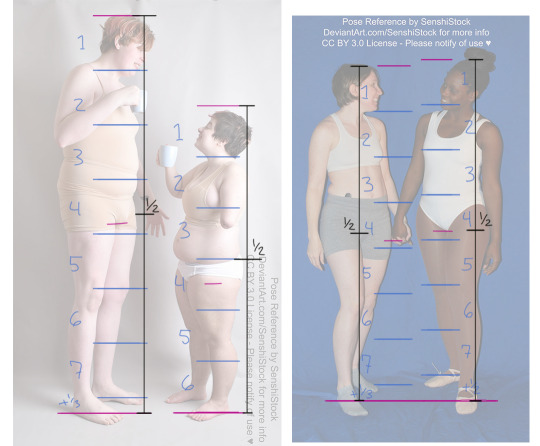
(2nd set from pose reference archive AdorkaStuck)
There are three interesting things here to look at: where the crotch is compared to the halfway point of the body, how many heads can "fit" on a body, and how tall any given head is.
Notice how the shorter someone is, the lower their crotch is compared to the midpoint of their bodies. The taller they are, the closer it gets to a perfect half. That means the lower body is less and less than half the full body as someone gets shorter (hip placement is another issue you can try figuring out yourself).
The taller someone is, the more heads fit in their total height. For our real people here, that ranges from 6 to a bit more than 8 heads, with the most common being 7-something.
You can also see that the height of everyone's heads (on the same picture) do not vary THAT much on average. On an adult person, there is little variation.

(take this with a grain of salt because of head angles, pixel precision, etc)
If you're not trying to draw hyper-realistic people, it's still useful to keep those proportions in mind to be aware of where you're cheating and how. It can prevent you from wondering why your short characters look like children, or why they just look like you scaled them down or up awkwardly. It's also useful to keep in mind when using a photo reference that doesn't match you character's proportions.
It's among a long list of shortcuts you learn as you draw frequently, like the wrist/crotch trick to know how long to make the arms compared to your character's body, or that a foot is as long as a forearm (try it).
There's always variations in human bodies so don't worry too much about it, especially if you're going for something very stylized. Learn the rules so you know how to cheat and trouble-shoot when things don't work out. For example, my standard character-drawing proportions range more often between 6½ to 7½ heads tall. If you go ask ancient Greece, they might say 9 heads are the ideal proportions.
Another fun fact, mannequins you see in stores are modelled on real people sculpted by someone to create the molds. The thing is, they usually add a bit more leg length than the model has, and very often make them stand on the ball of their feet, just so they give off the impression of even longer legs. Runway models wear high heels for the same effect.
#hopefully this is helpful!#if you want to imitate someone's artstyle- proportions like these are essential to get the right feel#it's like a signature#it's also probably a solid part of what makes people say their art style is inconsistant because it's really hard to stick to them when-#-you're not used to staying on model#ask answered#apparently i talk sometimes
39 notes
·
View notes
Text
Buddy Daddies character designer interview
Interview with Enami Katsumi (character designer)
Interviewer: This time, you were in charge of character design for an original series - how did you develop the designs for Kurusu Kazuki, Suwa Rei, and Unasaka Miri?
Enami: For Kazuki: I wanted to clearly get across the idea that, despite being an assassin, he's the caretaker figure for Miri and Rei. I was always working towards that, right from the start. Once I had a rough idea of his face, I tweaked his hairstyle and clothing according to requests, to nail things down.
For Rei: In the first draft, he was a well-built, tough-looking guy - the spitting image of an assassin. But once I heard the staff requests and got a better handle on his personality, I changed course and made him a slim man with a gloomy air.
For Miri: Since she’s the heroine, I very much wanted her personality to stand out. So I gave her facial features and hair that brought out her unique traits very clearly, and made her seem a bit older. I don't draw children all that much, so it was quite a struggle.
Interviewer: What did you consider the most important aspect in each of their designs?
Enami: For Kazuki: He's "a mother". I was told this at every planning session, so I made sure to bring out a certain softness in his physique and expressions - something like a mother's tolerance.
For Rei: I aimed to make his duality - of the shut-in otaku and the cool assassin - apparent at first glance. And I made him relatively slim, in order to bring out a clear difference between him and Kazuki.
For Miri: With "an ordinary innocent young child" as my goal, I cut back on the eyecatching characteristics, and made her hair shorter, so that her liveliness would come through more clearly, and her expressions would be easier to read. At first, I thought she might have ended up too plain, but I figured I would leave things up to the animation and voicing. I was really blown away when I saw her fully-voiced and in motion.
Interviewer: Was there anything else you got especially hung up on when it came to Kazuki, Rei, and Miri?
Enami: For Kazuki: The contrast with Rei was crucial, so I definitely wanted to give him a bright, slightly lighthearted air.
For Rei: When it came to Rei's assassin mode, I was thinking along the same lines as the rest of the staff, and so his attire and hairstyle were decided quite easily. Then I aimed to highlight a gap - I wanted his "off" mode to be idiosyncratic enough to be immediately recognisable.
For Miri: I was told that it was important for Miri to have an ordinary childishness and innocence, and so I was careful to give her childlike body proportions that would make it easy for her to express suitably childish actions.
Interviewer: Apart from the main trio, are there any characters you're especially attached to, whether because you're fond of their designs or for some other reason?
Enami: Ogino [Ryo]. Drawing quirky old men is something I really love, and in the final version, after weaving together all the staff's requests, he ended up looking even quirkier than I'd imagined. So he became my favourite.
Interviewer: When you first saw the complete footage of the characters in motion, what impression did you have?
Enami: Kazuki was exactly as I imagined, so my reaction was, "This! Yes, this!" Rei's "off" mode honestly surpassed my expectations. If I have the chance to draw him from now on, I definitely want to draw him with this sort of vibe. Miri's voice really is a full blast of childishness - I was amazed how thoroughly it makes up for the parts that couldn't be conveyed through the drawing.
Interviewer: Enami-san, do you think there is some common charm that the "Buddy Daddies" characters share?
Enami: We get to see their daily lives, and personalities that make them seem like the most unlikely assassins, and that makes them very endearing. And once Miri is thrown into the mix, all three of them display all sorts of delightful expressions - I want to keep watching them forever. Since them being assassins is built into the premise, we're bound to see a completely different side of them in future; I'm looking forward to it.
Interviewer: By the time this is posted, episode 3 will have aired. Are there any scenes from episodes 1 to 3 that you found memorable, or that you're especially fond of?
Enami: The scene where Miri says to Kazuki, "I hope Mama's not too lonely…" When they're talking about the difference from her mama's Hamburg steak, you can sense Miri's emotions brimming over; it's incredible.
Interviewer: Please tell us what you think are the selling points of this series "Buddy Daddies".
Enami: I think ultimately, it's the interactions among the trio. I hope that, as the story unfolds, people will enjoy watching the changing relationship between Miri and the two men under her thumb. Personally, my favourite thing is watching Rei in his "off" mode.
Interviewer: Finally, please give a message to everyone who is enjoying this series.
Enami: This is my first time designing characters for an original anime. I grew attached to these characters, and I'll be very happy if you become fond of them as well. I hope you'll thoroughly enjoy the main trio's adorableness.
174 notes
·
View notes
Note
What is your Hogwarts house?
I don't think that's considered a question in good taste anymore lmao.
And, actually, I never liked it much even as a kid, because sorting discourse did not adhere to the framework shown in the text. It consistently drifted to rigorous application of the ruleset laid out by the hat in its little song, which was blatantly called out as a convenient simplification about one page after the formula was originally presented.
Like. The fact that each cohort is broken down into four roughly equal pods and lineage is clearly a major determining factor, as is personal preference, is made clear very early. This is a cultural institution, that shapes the characters who grow within it quite as much as it's assigned based on their innate traits, and within the framework of which people actively look for identity elements to define themselves by.
People in my high school would be sorting adult fictional characters and doing elaborate balancing of their True Natures as revealed by their various plot events and defining life choices and patterns of behavior in their own generally dramatic canons and I'd be like. Okay, what do you think they were like when they were eleven though.
What were their values at eleven? What parts of their potential to be Like That were developed enough to show up on a psychic scan by a sapient hat, at eleven? What backstories are we assuming they're coming into this from; this man is a duke from fantasy medieval europe are we going to analogize him to a posh normie family, or the magic snobs, or are we dimensional-teleporting his baby self into wizard school?
Look, assigning Hogwarts houses to grown-ass adults on the basis of their adult developed identities doesn't make sense, that is very clearly not how anything works, this is a child-sorting algorithm. You have to apply it to children or it's invalid.
...also I was a Ravenclaw. I knew this. Everyone who had ever met me knew this. Any and every online quiz I was convinced to take knew this. I was so boring. I could not even make a serious case for my being one of the people who'd argue my way into another category I was minorly qualified for, or get there on family values or something, because I didn't want to not be a dumb nerd and my family is also dumb nerds. I was such an easy sort it was no fun at all, I was a walking stereotype.
It was embarrassing, is what it was. I was a flat character with no depth, rip child me. It was like if you could fail astrology by adhering precisely to your horoscope.
(My younger sisters wanted to be Gryffindor but consistently tested Hufflepuff and vice versa respectively, and I do not at this time remember which was which. The tests that gave you percentile rankings did give them minors in the ones they wanted tho.)
Anyway looking back on this in reaction to your ask, I find myself reflecting that House affiliation actually worked very much like gender, in that the way it was assigned was treated in-story as being based on absolute inherent qualities that defined a whole person, but quite clearly per the text actually worked by finding a schema you had an acceptable percent overlap with at a young age, and then setting you up to be perceived and instructed through that filter for the rest of your life.
The affiliation had meaning! But it was mostly meaning derived from the affiliation, and its social weight.
The ability of characters to find the sometimes deeply hidden Potential to live up to the person they aspired to be, thereby retroactively justifying the Sorting they had cajoled their way into, is like a major story element, you know?
I feel like this is yet another one of those places where rowling is a fairly gifted drawer of engaging caricatures; where when she was drawing on her actual lived experience (as opposed to hearsay and stereotype) to create something imitating that thing (in this case Belonging To Category) by intuition, the result would have nicely proportioned parts and some solid symbolic details, and work on an internal level more-or-less consistently, if not necessarily according to any strict logic.
Rather than being realistic it had a feeling of reality, which is in itself a perfectly reasonable way to approach light fiction. I often find myself wishing I could work in this more gestural manner sometimes, instead of drilling relentlessly down to detail.
The trouble is that things like those verisimilitudinous gaps between what people do and how they interpret their own doing, which lend the setting a great deal of dynamism, are only sometimes intentional, and the longer she extends any one bit and the more seriously she attempts to take it, the more likely she is to fall into the gaps and loudly deny that she has done any such thing, while digging herself into a pit of stupid.
#ask#hoc est meum#Anonymous#harry potter shit#i forgot the word horoscope for fully seven seconds there#i think trans sister wanted to be a hufflepuff#painfully cis ravenclaw is a funny concept tho#note that the funny language used here was not something i was capable of at 14
91 notes
·
View notes
Text
Characters' body proportions, "long legs syndrome" or why some people create hatred for the sake of hatred
First, let me explain to people who may not understand how proportions work in drawing.
I also want to remind you of a simple truth: change is not bad.
Note: I took extra art classes in elementary school for 4 years and then completed 5 art classes(years) at art school. During my last years of study I had the most wonderful teachers. Still love one of these teachers so much.
And that is why I am sure that what is now considered a trend and supposedly the norm is a VERY BIG mistake.
I've noticed a trend of hate towards Onmyoji's game developers, and while I agree with some of their f#ck-ups, I still want to remind you that there are PEOPLE LIKE US working there. Hateful comments are not constructive criticism!

So who here thinks that the characters supposedly have “long legs syndrome”? Where and how did you get this information and who told you THAT THIS IS TRUE?
I was just furious when I read this nonsense on Weibo, the worst thing is that people don’t even understand this and blindly believe it! Don't blindly believe everything the Internet gives you! You can always check for yourself or find people who understand this topic!
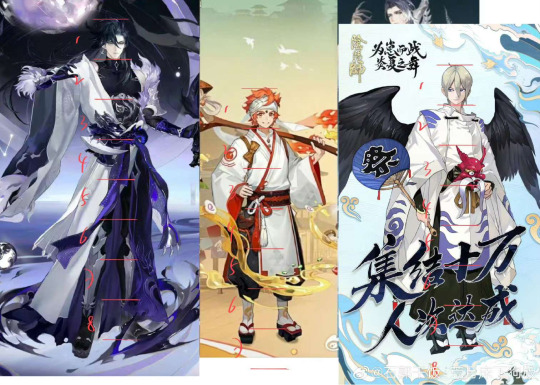
Today I found out that the art team has changed and we can actually see that this seems to be true as the latest designs have changed.
I see a bunch of accusations and dissatisfaction against the developers that they draw incorrectly. Again, has anyone seen a sensible answer other than just a comparison of heights compared to previous works?
Secondly, I want to break down this stupid idea of long leg syndrome in characters.
The correct proportions in drawing are considered to be 7-8 heads from head to toe.
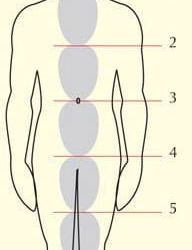
Hair growth, heels, levitation and other attributes are absolutely NOT taken into account. Only the skull and so the heads need to be counted 7-8.
There are times when artists can draw up to 9 heads in height. For example, big heroes.
Individual haracteristics, injuries (for example, a hernia in the back will make the height shorter, too tall growth will slightly change the proportions) must be taken into account.
The people “with long legs syndrome” are you and I look like in reality. Frequently, this is a European type of appearance. Asians, for example, have lower butts than Europeans (tested on Koreans lol), that’s why they think that our legs are longer, although they are also beautiful in proportion.
But another fun fact: we don’t have ideal proportions, because our fingers, arms, legs, etc. are longer and shorter by a few millimeters invisible to us.
But we're talking about basic anatomy in drawing, right? Teenagers and children have different proportions, but since they were not compared, I won’t describe them here; if you’re interested, you can find them on the Internet.
Proportions also differ between men and women.
+ in humans, proportions change with age.
For those who compare with the old character models in the game:
Apparently, the art team has changed. So now they do what they want. And they do it competently and correctly in terms of proportions in the drawing.
I don't judge past artists; Every creative person sees things differently. But the game continues to develop and this is ABSOLUTELY normal and natural.
I don't think that old models will be remade for the sake of correct proportions, they will be optimized, but not completely remade in a new way. I think it's cool, kind of showing respect to those who originally worked on the character model.
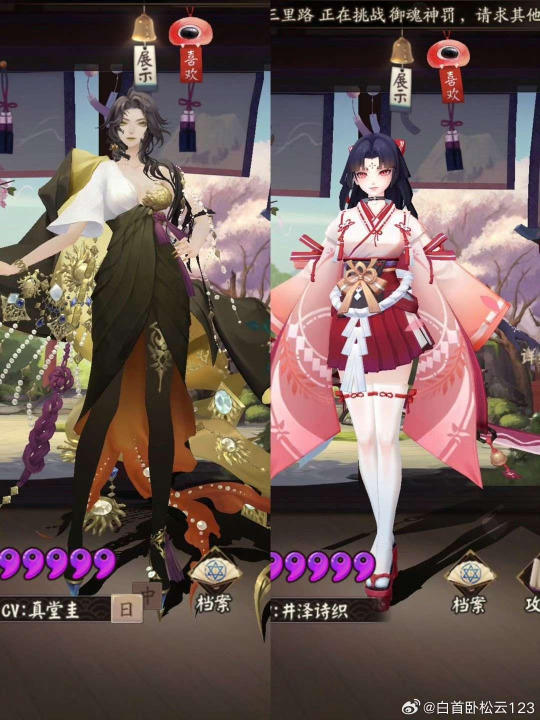
People suffer every day and express their hatred online. I do not defend the mistakes of the developers, but I also ask you not to incite hatred everywhere without understanding the topic well.
Also remember that sometimes mistakes happen. As one wonderful mangaka said when asked about the difference in the height of characters on different pages of the manga: there was an uneven floor somewhere!
I hope this post has helped you and now you see things from a different perspective. If you have questions, you can ask them here or in DM.
And if you have the chance, send this post to people who believe in "long legs syndrome" characters, or send them to the Internet to google information about correct proportions (o˘◡˘o)
#onmyoji#onmyoji susanoo#onmyoji tsukuyomi#onmyoji susabi#onmyoji izanagi#onmyoji taki#onmyoji cn server news
14 notes
·
View notes
Text
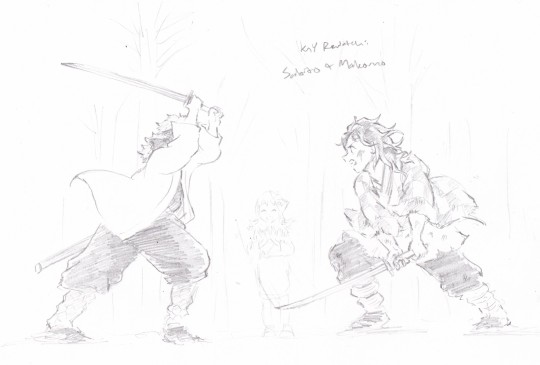
Things that came to mind while watching this episode:
-SWORDS
-Urokodaki's intro to the Corp is both necessary and info-dumping but in a way that I have lovingly come to accept as KnY style. However, the first time I watched it, I think I totally forgot about it.
--Also while watching it the first time, I was like, "whoa, more time has passed? More time has passed? MORE time has passed??" and later I was like "and Nezuko was conveniently asleep the whole time" but being as deep as I am now, I'm like, "yes, what a wonderful training montage, I love that Tanjiro kept a diary, Nezuko was working so hard this whole time too, yes of course Tanjiro took that much time to fully ingrain all that manliness into his muscles."
--Urokodaki comparing humans to demons and mentioning how human limbs don't grow back? Kind of on the nose.
--Mentioning how swords can break easily? Also kind of on the nose.
--I didn't intend for 'on the nose' to be a reference to the Tengu mask, and I even less intended for 'on the nose' to refer to Urokodaki's sense of smell. Seeing the connections now, I choose to stick with this phrasing.
--I know that Urokodaki was realistically trying to prepare his children to face monsters who actively want to murder them, but... did any of them die in training??? Those are real sharp objects! I can imagine Nezuko happily reading Tanjiro's diary later, but then pausing and looking up to stare incredulously at Urokodaki, appalled that he had nearly killed her only remaining brother.
--That being said, the Corp is an organization of some few hundred swordsmen (at any given time), with some huge portion more who died at the Final Selection, and some still more huge portion who failed to gain permission to attend the Final Selection. If we compare to, say, modern day competitive children's sports all going for the same championships, then it's not a large number. However, it does go to show the widespread damage demons cause, and how many children are driven to find putting their lives on the line to take down demons is their only remaining calling in life after having lost everything. Urokodaki has seen it so many times, so every time he accepts a student, he accepts someone who has given up anything else to live for, and he has to accept the consequences of their choices and how it may be out of his hands, all he can do is give them the best chance of survival he can and try to protect his own heart against the inevitable. Withdrawing from Tanjiro to leave him to his own devices may had been part of that.
--Ok, but also wouldn't it be funny if the scar on Sabito's face is from training with the traps on Mt. Sagiri?
--Hanae Natsuki had so many good sounds over the course of this training montage. Zenitsu gets the reputation for it, but let us never forget that Tanjiro is the OG "NE~ZU~KO~" screamer.
--Speaking of sounds, the sound of the sword as Sabito draws a real blade on Tanjiro at the end of the episode? CHEF'S KISS. Also, even if Sabito doesn't have a scent, he has manifested so much physicality that he's got remarkable sound effects as he attacks Tanjiro. And those flutes as he appears on the rock? So nice.
--AND THOSE ATTACKS, OH MY GOSH. THE HUMAN-ON-HUMAN SWORDPLAY IS SO GOOD. It's like Tanjiro said, not a singe wasted movement, Sabito's swordplay is so smooth and there is such a stark difference between him and Sabito in that first encounter. Also, SOMETHING I LOVE: Tanjiro blocks the first few strikes from Sabito with the hilt of his sword instead of with the blade. This goes to show Tanjiro's hesitation to use the blade, both for how it may deal damage and how the blade might take damage. It's after a few more blows that Sabito forces him to start defending himself with the blade instead of the handle. That was masterful swordplay storytelling.
--Gotouge, have you practiced martial arts? Breath technique is of fantasy level proportions, but so many core ideas and true training methods are on display so well.
--Random, but the bright coloring on Tanjiro's eyes in this episode? SO PRETTY. And so much focus on his facial expressions, especially in his concern for Nezuko. I was falling for this boy so hard by the time I got to this point in my first watch.
--But THAT SABITO SMILE, OH MY GOOOOSH
--There's a part of me that has always wondered if Tanjiro ever had a crush on Makomo, or at least found her somewhat cute initially before fully accepting her in more of a sempai role. In his experience, he's likely never encountered a girl like her before, and similar elements might had been what made him notice and ponder Kanao later on when he saw her with the butterflies. Not saying I think it would had been a serious crush or even anything he was aware of, I just wonder if he's always had a type (I mean, we know he did, I just wonder if Makomo fits his lily-of-the-valley-faithful-dog type).
--I love that Breath technique isn't necessarily a "summon your qi" kind of spiritual power, and instead focuses on oxygen and the physicality and wraps the psyche into part of one's overall physicality. That's pretty grounded martial arts technique, and likewise, I like how demons' abilities are also grounded in physicality (their bodies and blood having transformed) instead of, say, drawing power from outside sources like magic. But you could also poorly describe this series as "yogis vs Michael Jackson."
--You know what makes Makomo & Sabito's presence so believable, despite how Tanjiro found them mysterious and noticed right away that Sabito didn't have a scent? Mt. Sagiri, as a setting. This mountain is so much bigger than Tanjiro is, and Urokodaki is never shown saying more than he needs to for Tanjiro's training purposes, so for all Tanjiro knows, there are other children training concurrently, in their own pockets of the mountain. He's had to work so hard to gain his own mastery of Mt. Sagiri that he wouldn't be surprised to encounter people who know it better than he does, enough to be able to watch him while he wasn't aware (what with having his attention so focused on his own desperate training). As they probably don't have demon sisters to keep an eye on, it would make sense that he might be the only one to dwell with Urokodaki.
--That split boulder has become so iconic and I love it.
51 notes
·
View notes
Text
I hate how much 'bad' behaviour in children is centred around the concept of obedience/discipline. A "bad" child is one who doesn't clean their room when told. A "bad" adult is someone who mistreats their fellow human beings.
It is such an obstacle when you want to discuss decision-making, right and wrong, or the problems of (you know) 'following orders' with kids. In fact, it is a problem standing in the way of many conversations bc kids are taught that they can achieve being 'good' by doing what you say and agreeing with you.
Even when they're literally unable to do something you asked and you want to fix that situation to make it work (without any blame, just pragmatically trying to find a workaround around the problem), you have to do detective work bc failing to perform as expected = bad and they try to hide how they're struggling because they don't want to be 'bad'. Working with kids really made me realise how defensive they all are because of this attitude, how they think any attempt to solve a problem is a punishment or an attempt to find and accuse a culprit. So the moment you address that there is a problem you immediately get hit with "Well this isn't my fault!!" - "I didn't do anything!!!" - and now you're mitigating and problem-solving.
There is no sense of proportion, either. And a kid who struggles to do their homework will be made to feel worse about themselves than someone who mistreats and bullies their classmates but doesn't draw their teachers ire.
Among adults, if we say someone is a bad person, we usually mean that they do bad things. Bad behaviour is behaviour that hurts others. But with kids, words like that are used so much more liberally. Why do we do this.
87 notes
·
View notes
Text
Art Class - Some thoughts and notes
So, yesterday (17 April 2023) I had my very first official art class.
I've always been self-taught, and I find my art extremely lacking in some areas. After growing unhappy with my latest sketch, I contacted a colleague who I knew has a degree in Art, asking her if she knew of any classes. She offered to teach me (before you say anything: yes, I'm paying her), and yesterday evening we had our first lesson.
More under the "read more" because this is going to be really long.
She asked me to bring my most recent drawings and, between the digital drawings I printed and the pencil ones, I had I think 16 drawings. This also prompted me to get a folder where I can actually store it and keep it organized, so... Great.
I won't show the drawings I brought, but looking at them, my teacher said we need to work on anatomy and volumes (the depths).
She showed me some of her anatomy drawings and a book on anatomy. I'll either borrow it next time, or find a similar one at the library.
She proceeded to show me mannequins - you know, those very common ones you see artists use. She explained how normally, a human is actually 7 heads and a bit or an half, not 8, which is the "heroic" proportion used in comics. And then we looked at the mannequin, and she asked me to draw him.
So, as you can see, we started from the very basics.
First of all, though, she asked me "where do we start?"
The answer is "composition". She made me check the paper sheet and asked me to decide where I wanted to put it, and to find the highest and lowest point. Then, she asked me to divide that in half, divide those two parts in half, and again.
We didn't focus on the deeper anatomy, BUT we did focus on the proportions of the human body, and where the various parts of the mannequin/human body had to go if we looked at the various divisions I made.

The one of the left is the first drawing I made - she taught me where all the parts went, and how I could check proportions if the model/mannequin/whatever wasn't in a still position. She made me see that the hand takes from chin to forehead, the foot is the same length as the forearm, and how arms are way longer than I thought (they reach the halfway point of your thighs). Also how the bigger chest part ends where the last rib ends. It may seem really stupid, okay, but the realization stuck for me only when I saw my teacher point it out on her own body...
The second sketch I did in class is the mannequin walking, seen in side view. I fucking hate side view. Again, though, we looked at the proportion of the body parts and where they should go. My teacher made some corrections as I went, and I had to delete it and re-do it a few times.
Then, shit became harder by a ton. My teacher brought in a horse doll (the ones children use) and put the mannequin on it.
Again, we found the highest point and the lower point, but from my drawing you can see I didn't get it right. But the horse part for the composition was hard. She asked me how I could divide the paper, and I proposed in three parts and I did, but again, you can clearly see I screwed up because I thought the horse would be bigger.

We checked how the mannequin and horse related to the three parts, and we saw the back of the mannequin meeting the back of the horse was right at the end of the second part. Again, we divided the mannequin and then tried to see where it's body parts needed to go in relation to the horse. With some trial and error, we managed to do it, which makes me really happy. I also pointed out some horse anatomy to the teacher which she didn't notice herself that made the drawing better (I used to do horse riding, and my teacher then also gave us a lesson on horse anatomy fjdkdldl).
Somehow, an hour passed. My teacher gave me two sheets with drawings of mannequin figures doing things.
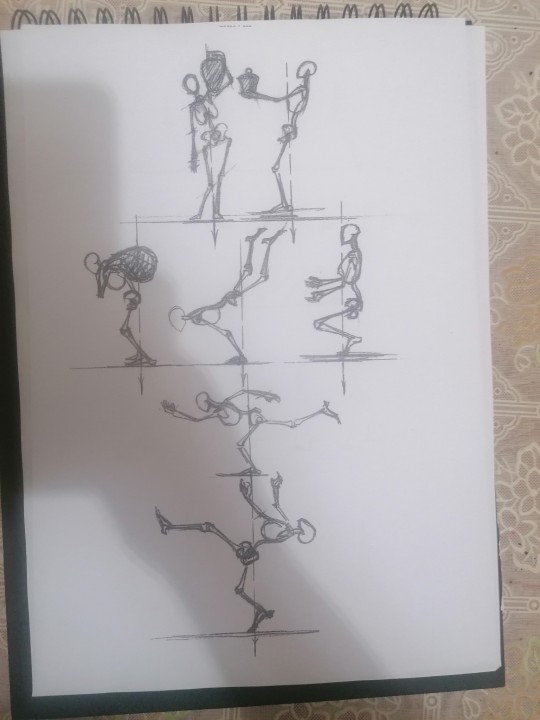
She asked me to do sketches of mannequins in various positions and to understand where the body parts go - or even not do the full mannequin but a skeleton like in the picture (so, I really need to get that anatomy book lmao)

The second sheet focuses on movement instead, particularly from the side.
I asked her if I could send her my homework sketches before the next class to see if what i was doing was correct, and she was really happy because she said she usually has to beg students to do it lol.
Since I want to improve and I want to use this blog more, as it deservers, I'll show y'all my future homework and stuff too
13 notes
·
View notes
Text
Artist Interview
Happy Boxing Day! I was tagged by @you-are-so-much-better-than-that in this artist interview.
1. Do you post on AO3? If so, how many works do you have on AO3? If not, where do you post?
I do post on AO3 as Suzy_Queue. I have two art galleries there, one for general art and one for Kinktober 2022.
2. What is your total art count?
If you count art done for other people's stories, headers for my own stories, and Gallacrafts pieces, it's around 150.
3. What are your top 5 pieces by likes/kudos?
I use this cool website to get my full Tumblr stats. According to them:
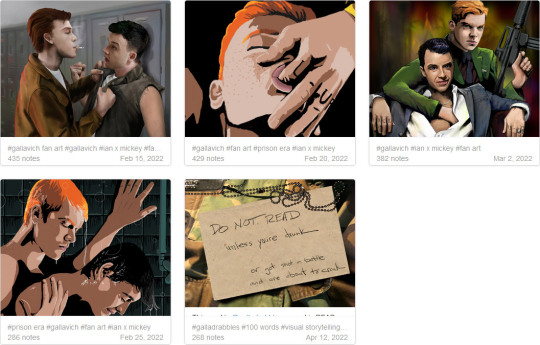
4. Do you respond to comments? Why or why not?
Yes! Although I'm not the fastest at it.
5. What is your current fandom, and what was the first fandom you drew for?
Currently, it's Gallavich all the way. The first fandom I remember drawing for was Teenage Mutant Ninja Turtles, making my own comics. (they were 7th-grade-girl bad).
6. Have you ever received hate on any art?
Nope, people are very supportive, even on pieces that I know aren't that great.
7. What’s a fandom/ship you haven’t drawn for yet but want to?
I can't really think of any.
8. What’s your all-time favorite ship?
The one that has lived in my brain for the longest part of my life is Han/Leia.
9. Do you draw outside of fandom?
Yeah! I was an art major in college. I've been a professional artist for 20 years and have created art for book covers, movie posters, album covers, logos. I go to figure drawing sessions at a local art school and am in a nature journaling group. I've displayed my horror art at conventions around the country.
10. What’s the an art piece you’ve drawn that came out completely differently than you expected?
This was the first piece I ever drew on a tablet with a pressure-sensitive pen. It was an experiment to learn the tools. I had no idea how it would look, and it turned out all right.

11. Do you draw smut?
Yep! There's some smut in this gallery.
12. Have you ever had any of your art stolen or copied?
Not that I know of.
13. Have you ever collaborated on a piece?
I've created art for stories working with the author, but I've never co-drawn a piece of art. Unless you count playing Exquisite Corpse with my children.
14. What’s an idea you have that you have yet to draw?
Oh, I have a lot. The one I think about most is a picture of Ian and Mickey in a lineup at jail, looking disheveled, hung over, and completely in love.
15. What are your drawing strengths?
I like my compositions a lot, the flow of items throughout the picture. I feel like I'm good at drawing what I see in a realistic way, whether it's a photo or real life.
16. What are your drawing weaknesses?
Drawing from memory/imagination. I have to have reference photos of what I'm doing or I go off the rails. I need to develop more trust in my own style and lean into weird proportions and my own skewed vision.
17. What’s your favorite art piece you’ve drawn?
I'm quite partial to this book cover art I did. It's spray paint, pastel, and acrylic. It's about 4 feet tall.

18. What is one thing you’d like to tell people about your art that they might not know?
Just because I've been doing it for a while doesn't mean I'm not still learning every day.
19. What inspires or motivates you to create for fandom?
I have a lot of emotional energy churning below the surface. Creating art and fics helps get it out. It's a much more positive outlet than letting it brew.
20. And finally, can you describe your process a little? Do you have a favorite place to draw? Do you play something in the background? Do you do research or just go for it? Give us a little insight.
I have a basement office where I write and draw. I bought a new table this year which I absolutely love. I do most of my creative work between 9-11 pm after the rest of my family has gone to bed. I do love music and play it a lot while I draw.
I research a ton. I spend a lot of time making photo compositions for every piece I draw, which are collages of body parts and other images.

Thank you so much for the tag for this interview!
27 notes
·
View notes
Text
Because of the piece I’m working on, I offhandedly commented to my spouse “I think I’m better at painting violins that people,” and that brought back a lot of internal rants I started to have in art college at how over-valued the ability to paint humans is. I grew up painting animal characters, but most of the classes on painting fundamentals that I took emphasized painting human figures and faces, which meant that I struggled a lot.
And one of the questions that came up frequently for me was why there was so much emphasis on painting humans. I could paint all kinds of animals super confidently, but that didn’t matter the minute teachers and other students saw that I didn’t exactly have a knack for human facial proportions or expressions. And conversely, if someone put an animal in their composition, it wasn’t critiqued super carefully. If it was there, great, but the human was the part of the composition that was really looked at, and where accuracy was the most important--regardless of the animal’s versus the human’s importance in the piece overall.
I wonder if part of it is that, as a “human” audience, it tends to take less effort to understand art that depicts other humans, than art that depicts un-humanlike creatures. We’re more or less in tune with human expressions, body language and actions. If an animal is depicted, it’s considered specialized knowledge--an extra degree of removal that you have to bridge the gap of understanding with. The thing is, I felt like I didn’t understand other people that well. I was more sensitive to animal bodies and expressions, so that’s what came naturally for me to paint. But since it wasn’t as intuitive for my teachers and peers to understand, it wasn’t as important in the curriculum to them.
And since we’re more in tune with other humans, it’s easier to see the mistakes made in images of people than images of other things. One particularly hurtful teacher in college said my humans were “ugly” because I couldn’t quite get the faces to look natural. But when animals were required in the composition, no one was told that their birds or their dogs looked ugly if they didn’t get the facial anatomy exactly right. Why did I have to get judged so harshly, just because I was more in tune with one thing than another? It’s been over five years since I’ve taken this class and I still get insecure about my human faces because of the comment that teacher made.
So part of it makes me kind of spiteful, like, why are students graded so heavily on their ability to paint one thing, when they’re maybe excellent at painting something else and it just gets ignored? Is it a “least common denominator” sort of thing where you have to be able to paint humans, otherwise “most” other humans aren’t going to care about your work? And why is it considered childish for me to prefer to draw animals, even if my painting style is clearly not a children’s book sort of style? Do humans just not want to put the effort into understanding something that doesn’t look like them on the outside?
I’m sure this happens outside art school too, if you just look at what kind of art is in the “canon” of painting overall. It just seems kinda... unfair to me.
#art college#art school#really tempted to tag this with the name of the art school I went to#but idk if it's a good idea
14 notes
·
View notes
Text
George R.R. Martin's Curious Collection of Grotesqueries (1996 - present)
Disabled
With the premiere of House of the Dragon, HBO had its work cut out for it. Not only did it face direct competition from Amazon’s unprecedented Rings of Power –a monumental production of costly proportions with a five-season pre-order – it also had to contend with the reputation of its predecessor, Game of Thrones. GoT set a new bar for what a TV production could be, paving the way for RoP. More than that, its final season underperformed in a way not previously seen in a critically acclaimed television series.
Series finales are a tricky business. No matter how carefully handled, it seems that series with large fanbases are unlikely to come away with endings that fulfill the whims of everyone. Lost, Mad Men and The Sopranos saw notable complaints from fans regarding their endings. The GoT series finale proved a different monster with a critic's score of 55% on Rotten Tomatoes and an audience score even lower in the 30s. This was a notable fall from grace for a show consistently met with widespread acclaim for the bulk of its run until its tail end, in which its source content ran dry, and the creative reigns landed in the hands of two inexperienced showrunners.
For five consecutive seasons, the show stunned audiences, smashing streaming records and captivating audiences as it brought the high-fantasy tropes of dragons, battles, and strategized politics, to the late-night universe of corseted boobs, morally grey characters, and the darkest parts of humanity.
Whereas Amazons Rings of Power could be enjoyed by most of the family, Game of Thrones was undoubtedly a series to watch after the children were put to bed, a welcome change for those who grew up playing D&D and then enjoying what Skinemax had to offer in the wee hours of the morning.
Author George R.R. Martin’s writing of A Song of Ice and Fire (the series on which GoT is based) reflects the dynamism of our world, a complex tapestry in which nothing so simple as “good” prevails over “evil”. It is a world in which the “good” guy can die, the “bad” guy can be a knight in shining armor (or a powerful woman demolishing gender norms), and every expectation of conventional storytelling you have based on ratings can be upended.
To date, research shows the greatest drawing point for both fans of Thrones and ASOIAF readers has been Martin’s writing of the characters themselves: a lush and seemingly endless array of diverse beings far beyond what high-fantasy readers were used to from 20th-century authors.
A 2020 study for the Proceedings of the National Academy of Science of the USA analyzed the correlation between character arcs, deaths, and their relationships with readers. In this, the study found that the number of named characters within the series was nothing short of monumental, however, due to Martin’s habit of axing them off (pun intended), their deaths often occurred at the right time for the reader or watcher’s brain to develop a connection with a new character. Characters who were overall favorites (with rare exception) of course, tended not to die (Jon, Arya, Tyrion, etc.)
Other reasons many people tend to cite for their love of the series? It’s a realistic portrayal of morality, the inclusion of sexuality, a feasible depiction of racial diversity (there is work to be done yet on House of the Dragon, but that is a post for another time), war strategy, and for book readers, Martin’s well-written descriptions of food do often make for good home cookbooks.
As a master of crafting personable characters who are complex and layered, with the capacity to be beloved and hated (looking at you Bobby B.), Martin introduced us to a new era of high fantasy writing that was bolder, brasher, and more suited to the 1990s and emerging millennium. With the passage of 30 years, perhaps faults can be forgiven then as we recognize the ways in which so few of his disabled characters achieve this masterful crafting, and question what excuse there is for House of the Dragon, and the creative liberties taken in its writing during the Era of Inclusion and Intimacy Coaching.
This essay will examine the way three particular characters fall into different stereotypes often bestowed upon the disabled community. Each character has been picked from a different part of the ASOIAF universe and as such may not be known to the reader: extra background will be given for context.
Larys Strong (House of the Dragon/Fire & Blood)
The Clubfoot

The first spinoff to land on HBO to much fanfare has been House of the Dragon, an adaptation of Fire & Blood, which retells the bloody civil war between two factions of the Targaryan clan which all but ripped apart Westeros some 167 years prior to the events of Game of Thrones.
For those completely unfamiliar with the narrative, the war is initiated when King Viserys I (for all intents and purposes the polar opposite of Daenerys’ brother), failing for years to produce a male heir, names his daughter Rhaenyra as heir to the Iron Throne. Despite Viserys’ intentions, the power of the patriarchy rules from the shadows as everyone from his new wife (and daughter’s former best friend) to his advisors and those he formerly considered friends conspire to install his new (drunk and disorderly) son on the Iron Throne in Rhaenyra’s place.
Two separate factions arise. On Rhaenyra’s side The Blacks, composed of Rhaenyra, her children, her husband-uncle (Targaryans, remember) Daemon, their cousins the Valeryons, and a camp of other royal families. The Greens are led by Alicent Hightower (who has assumed her maiden name upon Viserys’ death more or less), her father and Hand of the King Otto Hightower), her son King Aegon II (who is a lot more like Dany’s brother), Helaena (think a goth Luna Lovegood), Aemond (if Annie from Attack on Titan was a guy), Ser Criston Cole (the head of the Kingsguard and Rhaenyra’s ex-beau with an obnoxious grudge), and Larys Strong.
Larys is known by book readers by another name: Larys Clubfoot, and this is how he is visually introduced on the show, limping into the godswood the very picture of the scheming disabled villain who has graced many a James Bond film.
CTEV or Clubfoot is a common deformity that in our modern world is of course rectified with earlier onset treatment. Larys walks with a cane and from the onset is presented in juxtaposition to his brother, Harwin Strong: a handsome and charming man who becomes an eventual illicit lover to Rhaenyra. Larys has no lovers the object of desire to none. In his introductory scene as he limps into the godswood he is something like a creature of prey to the young Alicent, approaching her with a proposal as he offers her help for a price of which the cost will not be apparent for some time to come.
Larys becomes one of Alicent’s most important council members, brokering information for her as well as executing covert assassinations of her enemies. In Fire & Blood, nothing he does is seemingly with any purpose, his reasoning left only to the gods themselves. He is a man shrouded in mystery and given that the text is more of a biased history book than anything, this makes sense.
The show, frustratingly, also seems to take this approach to its detriment, and this also contributes to limiting him as a character. Unlike Varys whose machinations were often contributed towards “the greater good” and Littlefinger who sought to manipulate his way to the top for his own sake, Larys’ scheming ambles towards extremes for little reason, and what reason we are provided sets him over the edge into the territory of a freak-show caricature rather than a well-rounded character.
Feet.
It’s feet.
He’s doing it for Medieval feet pictures, or some version of them. The cost we were speculating on? The wolfish leers he teased Alicent with weren’t promises of something so simple as royal bastards he could manipulate her with, but a desire to simply gaze at her perfect arches while he touches himself and spills the secrets of her enemies.
The choice of writing a character with a disfigured foot as having a foot fetish is such an alarming choice it borders incredulity, particularly given that it was clear so much discussion was considered about diversity, sexism, and sexual assault in the writer’s room.
In almost all scenes Larys practically creeps in corners like an Andy Samberg Saturday Night Live skit. This is not to dismiss or perpetuate the oft-promoted idea that people with disabilities don’t have desires, kinks, or fetishes as detailed by speakers like Dr. Danielle Sheypuk and by sexual psychologist Dr. Justin Lehmiller.
There is something obscenely disturbing however about an able-bodied man portraying a disfigured character with a fetish related to that disfigurement which for all intents and purposes drives him to commit heinous acts–patricide included–that takes his characterization from one of Martin’s carefully crafted portraits to a questionable caricature whose 21st century writing ultimately lay in the hands of people who should have known better.
Tyrion Lannister (Game of Thrones/ASOIAF)
The Imp

Ask people about their favorite character from Martin’s high fantasy epic, and undoubtedly Tyrion will come up among the top three. As of 2021, community polling site Ranker still lists the character as the top ranked based on live voting results. Beloved among book readers and show viewers alike, his character stands to date as a marvel of modern writing, brought to life by none other than Peter Dinklage in a powerhouse performance for eight relentless seasons.
There’s a lot to praise here. There’s the fact that Martin wrote such a poignant character with Dwarfism who stands as a point-of-view perspective and is popular enough to feel relatively safe from beheading all things considered. He is a man equal parts charming and pitiable, enviable and intelligent. Had he been born in a different body he would be granted a much different life, and it is his disability that serves as a barrier despite all the privileges the last name “Lannister” bestows on him (which is a lot).
Through the richness of Martin’s writings, there seep flaws in his characterization notably absent from the television show, which depict what can only be described as the best sides of him. He is “prettied up” of course in the way all actors are in a Hollywood show, his rougher aesthetic smoothed away by the handsome presence of Dinklage. Other aspects of his behavior however make no appearance, from cruder actions that make him appear more morally dubious to Martin’s fixation on forcing him to perform odd tricks and feats like some Florida carnival act, to his almost-rape of Sansa and the murder of the character Marillion.
“Waddling” is a word often used to describe Tyrion’s gait, his POV chapters packed with allusions to the stiffness of his hips, and the aching of his joints. For those with physical disabilities, there is no mistaking or ignoring the reality of chronic pain or discomfort: life inside a tortuous iron maiden that all at once does not allow you to sit still yet punishes movement. Yet for no other characters are similar measures taken.
For instance, when Jon Snow loses the use of one of his hands, every other sentence isn’t dedicated to describing it, nor Ned Stark’s broken leg. Some descriptors yes for Martin is, as mentioned, a master of his craft, yet in Tyrion, there is an excessiveness to it, a level to which it is as though we are made not to forget he is different.
Throughout the series he plays into the role further of the carnie, doing things like flips and mid-air twirls. The physical characteristics neglected in favor of Dinklage’s good looks reinforce the fact that in the books, he must rely upon the power of coin for a woman’s (temporary) love, unlike his brother Jaime who practically has half the women in the kingdom swooning after him. Even gold diggers after the Casterly Rock goods are suspiciously absent, as though Tyrion is so abhorrent none but the whores will have him, and so in equal parts, he becomes a character who we fall in love with while falling short of the true measure of all a disabled character can be.
Patchface (ASOIAF)
The Lackwit
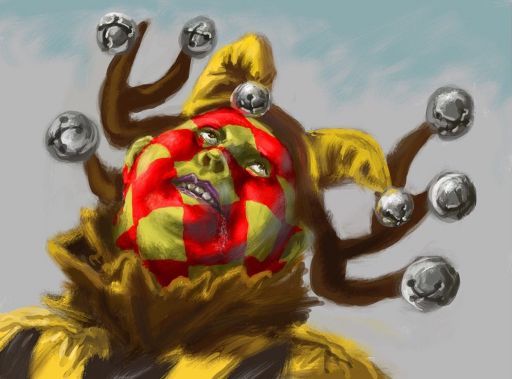
For the unread, Patchface may be a new character. He doesn’t make an appearance onscreen but is alluded to in a brief Easter Egg during Season 3 of Game of Thrones in a song sung by Shireen Baratheon.
Prophetic characters are a narrative theme throughout the series, appearing to sometimes guide major POV characters in what will inevitably be their most consequential decisions. Daenarys, Cersei, Jon, Stannis, and Arya all encounter characters entangled directly with prophecy, and Patchface appears as one of these curious figures whose overall purpose is more or less unknown but hinted at as something bigger in the grand scheme of things.
So named for the colorful tattoos marking his skin, Patchface was freed as a Volantine slave by Steffon Baratheon, the father of Stannis, Renly, and Robert during a trip to Essos that resulted in tragedy. Recognizing the young boy’s brilliance, Steffon intended to bring him home to Storm’s End as a court jester for the boys. Upon his return, a storm wrecked his ship in the bay, killing him and his wife. From the ramparts, his sons watched as the returning fleet was demolished and in the ensuing days, the boys were forced to face the fact that they were orphans when naught but carcasses came to shore.
Patchface was the only survivor, his formerly recognized brilliance replaced with cognitive and intellectual impairment from a mixture of trauma and oxygen deprivation. Henceforth he lost all memory and the ability to speak in coherent sentences, instead only communicating in short snippets sometimes regarded as prophetic by those who listened at the right time.
Occasionally, his words alluded to the watery depths, and he was designated as the court jester for Storm’s End, eventually becoming a play friend to the young Shireen Baratheon. In some ways, Patchface’s existence (and by existence, that of Bran’s) can be seen as an extension of That Magical Cripple.
Narratives centered around disabilities have often depicted people in a state of overcoming or possessing some type of superhuman ability that somehow makes them magical. Similar to the Magical Negro trope, they use this ability to the benefit of those around them, rather than themselves, selflessly repairing a thankless world because it’s not enough to simply be. They do not learn or better themselves in any way, but rather, aid the hapless and needy around them with superhuman abilities. It is not enough to exist as a person with a disability, especially within a quasi-Medieval world whereupon they are seen as a boon to society. Rather, they must possess some ability to furthers the progress of a hero beyond themselves.
In the case of Patchface, his prophetic abilities come to a head on a cliffhanger. A Dance with Dragons leaves off where Season 5 of Game of Thrones saw its conclusion: Jon’s confrontation with the mutineers at The Nights Watch led by Alliser Thorne, spurred by his decision to investigate the goings on at Hardhome. Patchface alludes to visions of “the crows…white as snow” and “the dead are dancing”, possible allusions of wights and White Walkers while at Castle Black. If there is one thing we have learned in the ASOIAF universe, it’s that heeding the advice of the eccentric’s omens may save lives. Aside from that though, who really is Patchface? What real desires does he have? After all, even people with cognitive disabilities want for something, as any caretaker regardless of the decade can tell you.
Throughout his series, George R.R. Martin weaves a rich tapestry of characters of many different colors, rich hues, and vibrant features. For the many complaints arising in a more inclusive culture that demands more of authors now than ever, we can recognize for what it's worth, he did a good job for a white man writing high fantasy in the 90′s when his predecessors had never deigned to feature a skin tone duskier than tan, a sexuality that wasn’t heterosexual, or a suggestion of life that wasn’t based on Christian morality.
And yet for all this, Martin’s portrayal of the lives of disabled people is a one-dimensional portrait that turns them into a 1940s-style Freak Show in Juno, Florida. Lovable characters like The Imp, and reprehensible characters like The Mountain are painted as tropes defined by their physicality and the nature of their disabilities–lest we forget them and it is clear this bias extends to showrunners and directors currently working on House of the Dragon almost 30 years later.
As nature is a spectrum so is representation, there can be good, bad, and all manner of in between, and while we can find love and cringe-worthiness in the depiction of these characters, so can we find hope for the future disability in fantasy alongside racial and sexual diversity as well.
Catch up on Game of Thrones and House of the Dragon via HBO or any of its streaming apps, or better yet, rent it for free at your local library along with the accompanying materials.
Citations:
https://uproxx.com/tv/how-much-did-lotr-the-rings-of-power-really-cost/
https://www.townandcountrymag.com/leisure/arts-and-culture/a41547050/rings-of-power-season-2-news/
https://www.rottentomatoes.com/tv/game_of_thrones/s08
https://www.pnas.org/doi/10.1073/pnas.2006465117
https://www.sexandpsychology.com/blog/2019/9/6/sex-and-disability-intellectual-disabilities-and-the-right-to-sexuality/
https://www.youtube.com/watch?v=7PwvGfs6Pok
https://www.ranker.com/crowdranked-list/best-game-of-thrones-characters
https://open.spotify.com/track/43sz4PFPSPqCzJVRnsgPXT?si=78ec2e67ed1949c5
#visibilityarchives#thevisibilityarchives#tva#house of the dragon#hotd#larys strong#tyrion lannister#patchface#asoiaf#grrm#disability#inclusivity#disability visibility#game of thrones
13 notes
·
View notes